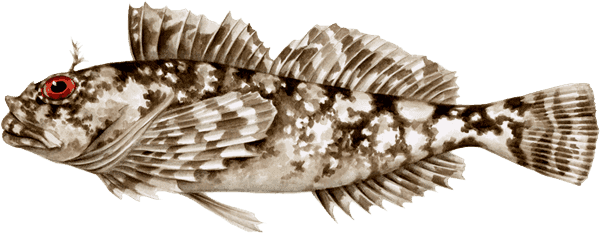Cabezon

Species Details
Scorpaenichthys Marmoratus
Cottidae
Scorpaeniformes
Kelp Forests
25 - 31 lbs.
10" - 39"
Cabezon (Scorpaenichthys marmoratus) Fish Description
Also known as sculpin, and ‘mother-in-law fish’ because of its loud mouth and constant croaking, the Cabezon is a large, smooth and scaleless fish that is the only species under its genus.
Cabezons have broad bony support extending from the eye across the cheek just underneath their skin; they also have a stout spine just before their eyes. They have 11 spines on their dorsal fins. Their anal fins have soft rays. Their mouths are wide and contain several small teeth. They have a pair of flaps behind their eyes. Usually, their color varies from brown to green and red. They have several dark mottling that helps them camouflage.
Diet and Size
Cabezons love fish, fish eggs, crustaceans, and mollusks. They also enjoy abalone, prawns, and squid, crabs, and octopus.
Cabezons can grow up to 3 feet and 3 in and weigh up to 31 pounds. Female Cabezons tend to be larger than male Cabezons of the same age.
Interesting Facts About the Cabezon
- More than 90% of the green Cabezon fish are female, while more than 90% of the red Cabezon are males.
- The flesh and internal organs of the Cabezon are blue in color. Once cooked, its flesh turns white.
- Its name is derived from the Spanish language meaning ‘large head’ or ‘stubborn’. The Cabezon’s head is relatively larger than its body is its primary identifying feature.
- Because Cabezons don’t have swim bladders, they do not suffer from barotrauma like other bottom-dwelling fishes.
- Cabezons are ambush predators; they can remain almost motionless while patiently waiting for their prey. Then, they devour their prey using their very large mouths. Still, they fall prey to other larger fishes.
- Eating Cabezon fish roe can lead to gastrointestinal toxicity.
Fishing Techniques
Cabezons are popular as a prized game fish to anglers. However, it must be noted that Cabezon roe (eggs) is harmful to humans due to the presence of the toxin phospholipid dinogunellin in their system.
Fortunately for anglers, Cabezons are available for fishing all year-round except for March to April when some fisheries are closed. Anglers can use hook and line, rod and reel, and pots and traps to capture the Cabezon. Another effective method of catching Cabezons is using rubber-tailed jigs tipped with tempting bait (small crabs, shrimp, and mussels can be used). Anglers should make sure that they fish within a foot or two of the bottom to secure the Cabezon who tend to hold the line firmly and even attack the bait.
Anglers can also use a pole spear to snare the Cabezons.
As of 2006, the minimum size of the Cabezon fish that can be caught was increased to 15 inches to protect the young ones from overfishing.
Habitat and Distribution
Cabezons thrive in several kinds of habitats ranging from 0 to 656 feet deep. They like kelp beds, and rocky, muddy, and sandy bottoms. They also inhabit the top part of rocky ledges as opposed to the lingcod and rockfish who prefer the shallower parts of these areas. Cabezons spawn in shallow waters; the mature male Cabezons monitor the eggs until they hatch, making the former vulnerable to being caught. The juvenile Cabezons tend to hide under floating kelp; when they mature, they move to tide pools and eventually to kelp forests where they spend most of their adult years hiding in the shadows.
Cabezons are native to the Pacific coast of North America from Alaska to Baja California.







